Strawberry is the most long-awaited and demanded in the middle lane berry for most consumers. Unfortunately, its mass ripening season is very short. Usually it is only 2-3 weeks in late May and early June. But amateur gardeners often grow homemade strawberries at home, right on the windowsill at any time of the year, getting small yields of this beautiful berry.
Material Content:
- 1 Technologies for growing strawberries at home all year round
- 2 Varieties for year-round breeding
- 3 What to choose - seeds or seedlings?
- 4 Conditions for growing a berry crop
- 5 Strawberry care at different times of the year
- 6 Key secrets and subtleties of year-round strawberry cultivation
- 7 The reasons for the lack of fruiting
Technologies for growing strawberries at home all year round

Home growing of any culture is characterized by small areas due to the limited size of window sills and a number of difficulties in maintaining the required lighting and humidity. However, those who take this seriously, usually builds a small greenhouse for strawberries, or adjusts a balcony for this.
Potted strawberries in winter
The best option with this method is to dig a strawberry bush in the fall and store it in the cold until mid-December. Further, the bush is awakened, forced to grow actively and yield crops in early spring.
The dug bush is planted in a pot according to the size of its root system. The soil can be prepared from 1 part humus, 1 part land from coniferous forest, 1 part sand. But also suitable purchased soil for strawberries or universal.
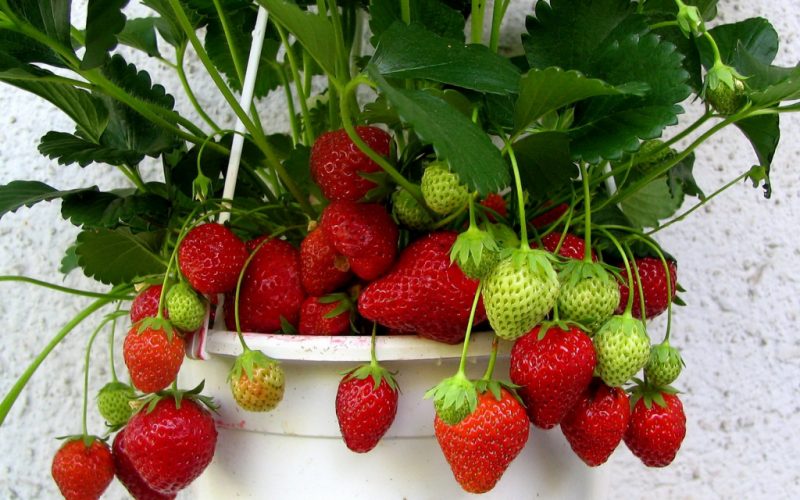
The pot is placed on the balcony or in another cold room and stored at a temperature not exceeding +10 degrees, infrequently watered.At the same time, you don’t have to worry about the lack of lighting, since under this mode the processes of photosynthesis in plants cease.
To awaken strawberries, they bring it into a room with room temperature (you can immediately on the windowsill) and wait for the first new leaves to appear. When this happens, it is necessary to illuminate the bushes. In December and January on cloudy days, the duration of the backlight is usually 3-4 hours a day, on clear days 2-3 hours are enough. In February, it can be reduced by 1 hour, and at the beginning of March it can be included only in cloudy weather for 1-2 hours. Since mid-March, additional lighting is no longer required.
A more difficult way is strawberries from seeds. In this situation, the first crop can be obtained only in May, and for this you will have to try.
Seeds are sown in January-February in shallow containers with sandy soil. A mixture of purchased soil for seedlings and coarse sand is suitable. Seeds do not need to be covered with a layer of soil, just distribute it on the surface. After that, the soil is sprayed from the spray gun, and the container is covered with a plastic bag or a mini-greenhouse.
Shoots appear after 3 weeks. They are kept on the windowsill at room temperature and must be illuminated, preferably with phytolamps or with DNAT or DNAZ lamps.
Important! Seedlings dive after 2-2.5 months, when it reaches a sufficient size, and for the grown seedlings induce a fertile soil mixture.
Using off-the-shelf automated systems
The easiest way for those who are willing to invest, is to purchase a ready-made automated system for growing strawberries. In the Russian market, the Fazenda Green system is popular.
It represents a wall shelf with three shelves, each of which has 7 pots. Each shelf is illuminated with a phytolamp with a perfectly selected emission spectrum. Also, a compact drip irrigation system is connected to each tank.
The system is equipped with sensors that monitor the level of illumination on the shelves, humidity in the pots and they themselves regulate the on and off lamps, water supply.
Bag growing
Growing strawberries in bags is no different in principle from cultivating it in pots. A feature of this technology is the ability to plant bushes in several rows. This saves space in a cramped balcony or small greenhouse.

For this, a bag of polyethylene or burlap is densely packed with soil, sealed, and placed vertically. Then - holes for planting bushes are carefully cut with a knife in it. The distance between the holes is 10-15 cm. You can cut them in many rows along the entire height of the bag.
Saplings (taken from the beds or grown from seeds) are planted in cut cells. Further care for them is the same as when growing in pots.
The use of hydroponics
Hydroponics is an advanced method of cultivating crops indoors. With this method, productivity sometimes increases several times than with traditional cultivation in the soil.
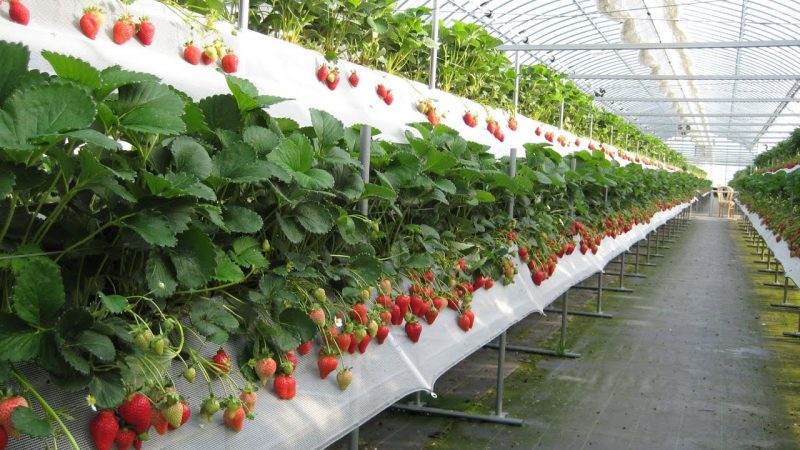
This is achieved thanks to a number of factors conducive to success:
- the ability to accurately dispense feed;
- water saving (the same water can be reused);
- lack of weeds;
- compact placement of plants in several levels.
The hydroponic method requires special equipment that you can either purchase or make yourself.
To make a hydroponic installation, you will need PVC pipes with a diameter of 10-15 cm. In them, at a distance of 10-12 cm, holes are made for the size of the pots. The pipe system can be placed in several rows horizontally one above the other. At the highest point is a container with a working nutrient solution.
Often, such a system is equipped with a pump and an automated system that allows 2 times a day for 5-10 minutes to run fluid through the pipes, pump it into the upper tank and again let it go in a circle. A tank is enough for home conditions, and the solution can be run manually by opening the valve 2-3 times a day.
Important! Pots are preferably plastic with large drainage holes. Their size should correspond to the volume of the root system of the grown strawberry bushes.
Strawberries are placed in pots and fixed either using a special hydroponic substrate, or thanks to pebbles, expanded clay.
Pots are inserted into the pipes and carry out a test run of the liquid for 5 minutes. As a result, strawberry roots in all containers should be wetted at least 2/3 of their height. If this condition is met, then the system is ready for use.
Varieties for year-round breeding
For home conditions, only repairing ampelous varieties of strawberries are suitable. This will provide constant yields of berries throughout the year, as these varieties are able to bloom and bear fruit regardless of the season. Also, the bushes of such strawberries are very decorative, therefore they will serve for aesthetic purposes.
Removable strawberries are represented by a great variety of varieties, and new ones appear every year. But the requirements for them for home cultivation remain unchanged.
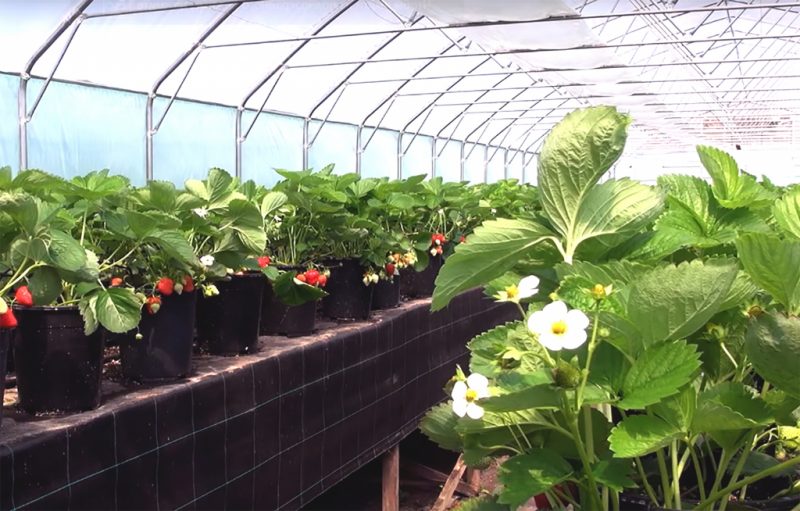
They have to:
- be capable of self-pollination;
- have high immunity to fungal diseases, resistant to adverse environmental factors (primarily temperature);
- have precocity;
- to form large berries (according to the principle: less, but better).
Here are just some of the possible options for growing a house: Pineapple, Selva, Crimean remontant, Queen Elizabeth, Garland, Geneva, Darselect, Moscow delicacy, Sakhalin.
What to choose - seeds or seedlings?
All florists, summer residents, gardeners who are wondering what is preferable: to grow a repairing strawberry from seeds or propagate a mustache - you need to remember one important point once and for all. Repairing varieties propagate only by seeds!
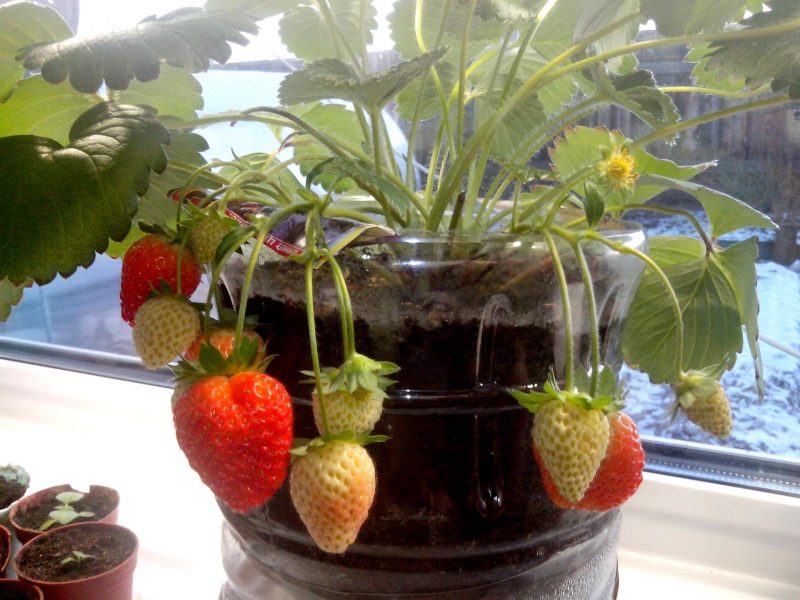
However, if we are talking about growing strawberries at home by the method of forcing it, then, of course, it makes sense to dig a bush from the garden, which at one time was obtained from seeds. In other words, to grow a bush from seeds at home is a longer and more laborious process, which, however, is also practiced.
Conditions for growing a berry crop
The main factor that allows a repairing strawberry to bear fruit throughout the year, and not just in high season, is the timely application of fertilizers.

There are several recommendations for growing strawberries at home:
- Lighting. It should be enough, especially in winter. At a minimum, you need to use 2-3 fluorescent lamps per 1 bush, but it is strongly recommended to purchase phyto-lamps.
- The soil. At home, strawberries are often affected by fungal diseases, so the soil is either purchased in a special store (where it is already decontaminated) or disinfected on its own. The best methods of disinfecting are calcination, watering with phytosporin and a weak solution of potassium permanganate.
Strawberry care at different times of the year
Strawberries at home often suffer from a lack of light and drafts (in winter), dry air (in high summer), and fungal diseases.

Therefore, it is important to properly care for her at different times of the year.
- In late autumn and early winter, while strawberries are on a winter "vacation", it is rarely watered. The main thing is not to overfill, thereby preventing rotting of the root system.
- When it is brought into the room, the main factor becomes backlighting, since in winter and early spring there is an acute shortage of sunlight.
- The first dressing can be done only when the first flowers appear.If we are talking about the method of distillation, then this happens in March, and if the plant is grown from seeds - in early May. To do this, use either complex organic fertilizers or a mixture of mineral fertilizers with an equal content of nitrogen, phosphorus, and potassium. If in the fall the plant was planted in new soil, then you can completely dispense with top dressing or bring the solution to a lower concentration than indicated on the package.
- In summer, strawberries need moderate watering and top dressing. Regardless of whether the method of distillation or cultivation from seeds is used, strawberries are fed with complex fertilizers 2-3 times during the summer, and also 1 time in September (which will make it possible to collect another 1-2 autumn crops).
- In extreme heat, strawberries are either taken out into the shaded area or outfitted with containers of water in order to increase air humidity. They do exactly the same in winter if the heating batteries too dry the air.
- In the first half of autumn, you can continue to care for the berry as if the summer had not yet ended. Since the end of September, artificial illumination is included for 1-2 hours a day. When the strawberry finally ceases to bear fruit, the owner has the right to decide its fate: plant it in open ground, transfer it to the balcony for wintering or get rid of it.
Practice shows that at home it is very difficult to keep the bush until the next season. Even if this succeeds, the strawberry is not already bearing fruit as abundantly as in the past. Therefore, the best solution is to plant it in the garden, and the next year - take a bush from open ground or stock up on seeds.
Key secrets and subtleties of year-round strawberry cultivation
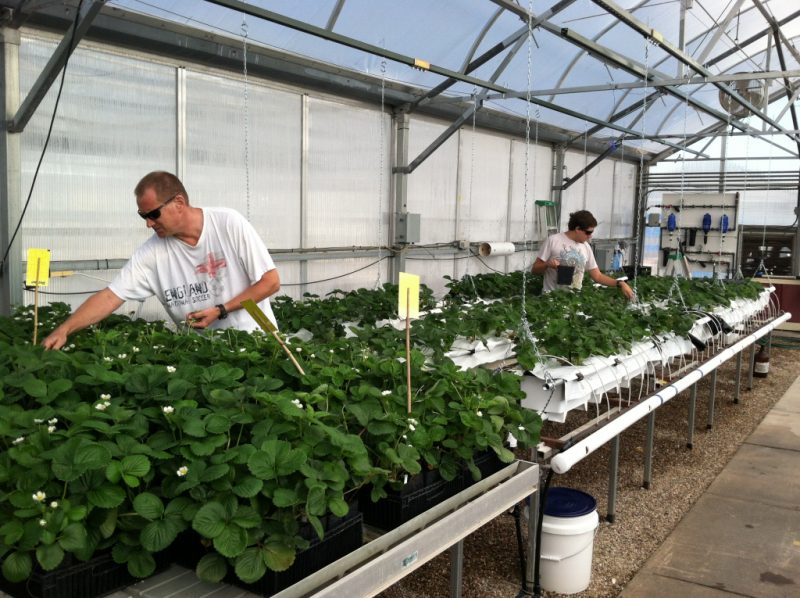
Growing strawberries at home all year round is provided not only due to the selection of a repairing variety, but also other not complicated secrets:
- With the method of distillation, gardeners use one trick that allows you to stretch fruiting for all four seasons. For this, the dug strawberries are stored in an ordinary refrigerator. The bushes are not awakened at the same time, but in waves with a difference of a month. Thanks to this, you can even achieve year-round fruiting of strawberries! That is, the first bushes to extract in December, and the last - in May. With proper care, the latest ones can give the last harvest even in winter!
- The second secret is manual pollination. Above, it was already recommended to purchase self-pollinating varieties, but additional manual pollination, as practice shows, increases productivity.
The reasons for the lack of fruiting
If the strawberry does not bear fruit, then it is obvious that some mistakes were made in its cultivation. But which ones?
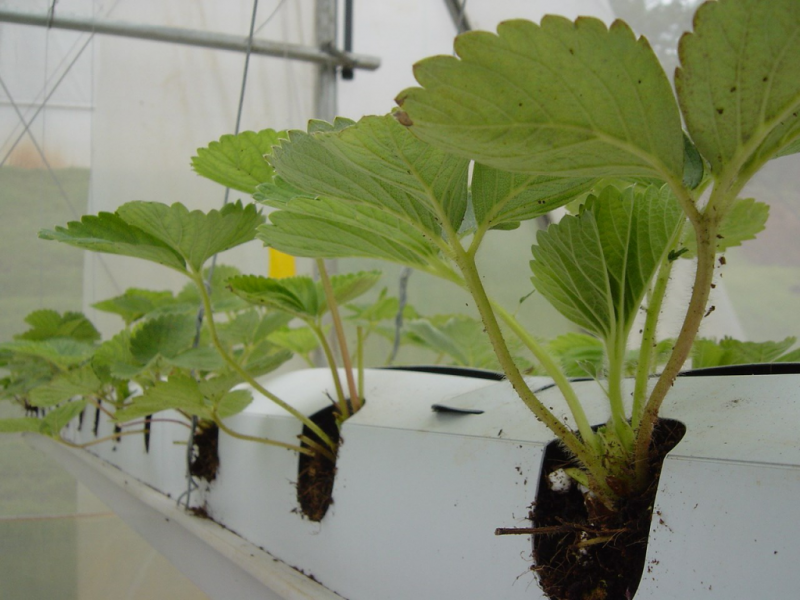
Consider the most common of them.
- Overfilling with nitrogen fertilizers. As mentioned above, strawberries are fed with complex fertilizers with approximately the same content of nitrogen, phosphorus, and potassium. If the balance is upset in favor of nitrogen, then strawberries will actively build up green mass, preventing the fruits from forming.
- Lack of lighting. This is especially true in the winter and until mid-March. In winter, this demanding culture of light is sorely lacking. Luminescent lamps give a very weak luminous flux, and if strawberries were illuminated by them, then it is not surprising that it does not bear fruit. Those who seriously want to do this business should purchase either special fittings or powerful DNAT or DNAZ lamps from 250 watts.
- Lack of top dressing. Starting in May, strawberries need phosphorus-potash and complex nutrition. Do not neglect this.
Growing strawberries at home is not too simple, but not too difficult. It is a demanding and vulnerable culture that yields unusually valuable results. Probably, everyone would dream of getting the long-awaited berries at a time when the strawberry season has long passed or has not yet begun. Well, everyone now has such a chance. Armed with knowledge and patience, anyone can succeed in this direction.












